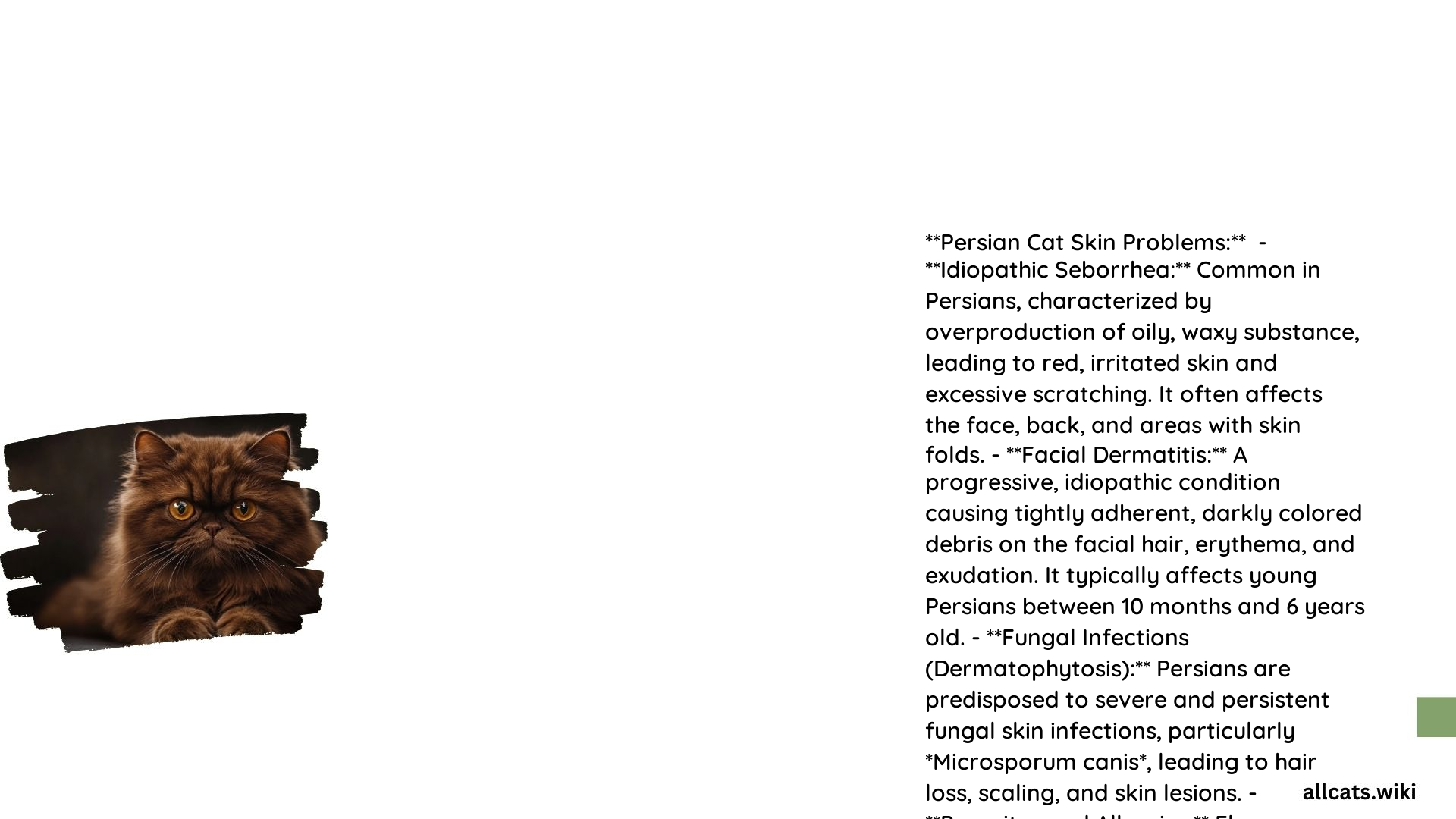Persian cats are prone to various skin conditions due to their unique physical characteristics and genetic predispositions. From feline idiopathic seborrhea to dermatophyte infections and allergies, these fluffy felines can face a range of skin-related challenges. In this comprehensive guide, we’ll explore the most common Persian cat skin problems, their symptoms, causes, and effective treatment options.
What are the Common Skin Conditions in Persian Cats?
1. What is Feline Idiopathic Seborrhea in Persian Cats?
Feline idiopathic seborrhea is a common skin condition in Persian cats, characterized by an overproduction of an oily, waxy substance. This can lead to red, irritated skin, a bad odor, and clumping in the fur. The condition can manifest as either seborrhea sicca (dry and flaky skin) or seborrhea oleosa (oily and greasy skin), often in combination.
2. What are the Symptoms of Dermatophyte Infections (Ringworm) in Persian Cats?
Dermatophyte infections, commonly known as ringworm, can cause hair loss, scaling, and thickened patches of skin in Persian cats. The lesions are often seen on the head, chest, back, and forelegs, and the skin may appear scaly with round, thickened patches and hair loss.
3. What is Facial Dermatitis in Persian Cats?
Facial dermatitis is a condition that primarily affects the facial folds of Persian and Himalayan cats. Symptoms include adherent dark facial debris, erythema (redness), and exudation (discharge). As the condition becomes chronic, the pruritus (itchiness) can become intense.
4. What are the Symptoms of Allergies in Persian Cats?
Persian cats can develop environmental or food allergies, leading to excessive scratching, licking, or chewing of the fur, redness and swelling of the skin, loss of fur, and scabby or scaly skin.
How are Persian Cat Skin Problems Diagnosed and Treated?
Veterinary Interventions for Diagnosis
To diagnose the underlying cause of a Persian cat’s skin problem, veterinarians may perform a variety of tests, including:
– Physical examination
– Chemistry panel and complete blood count (CBC)
– Hormone analysis
– Skin scraping
– Bacterial and fungal culture
– Skin biopsy
Treatment Costs for Persian Cat Skin Conditions
The cost of treating Persian cat skin conditions can vary widely, depending on the severity and type of condition. For example, antifungal treatments for ringworm can range from $50 to $200 per month, while managing idiopathic seborrhea may cost around $30 to $100 per month for shampoos and supplements.
Timelines for Recovery
The recovery time for Persian cat skin conditions also varies. Ringworm treatment can take several months to a year, while managing idiopathic seborrhea is often a long-term process requiring regular veterinary check-ups.
How to Provide At-Home Care for Persian Cat Skin Problems?
- Regular Grooming: Daily grooming is essential to prevent dander buildup and keep the cat’s coat and skin clean.
- Medicated Shampoos: Use antiseborrheic shampoos or antifungal shampoos as prescribed by the veterinarian.
- Environmental Cleaning: Thoroughly clean the environment, especially for fungal infections, to reduce spore contamination.
- Dietary Management: Ensure a balanced diet and consider hypoallergenic diets if food allergies are suspected.
- Monitoring: Regularly monitor for signs of skin problems and schedule follow-up exams with the veterinarian.
By understanding the common skin conditions affecting Persian cats and following the appropriate at-home care and veterinary guidance, you can help your fluffy feline friend maintain healthy, comfortable skin.
References
- PetMD – Feline Idiopathic Seborrhea: Inherited Skin Disease in the Persian Cat – PetMD
- Untamed – Persian Cat Skin Conditions: Persian cat skin conditions and adequate treatments – Untamed
- WSAVA2008 – Facial Dermatitis of Persian and Himalayan Cats: Breed-Based Skin Diseases – WSAVA2008 – VIN

